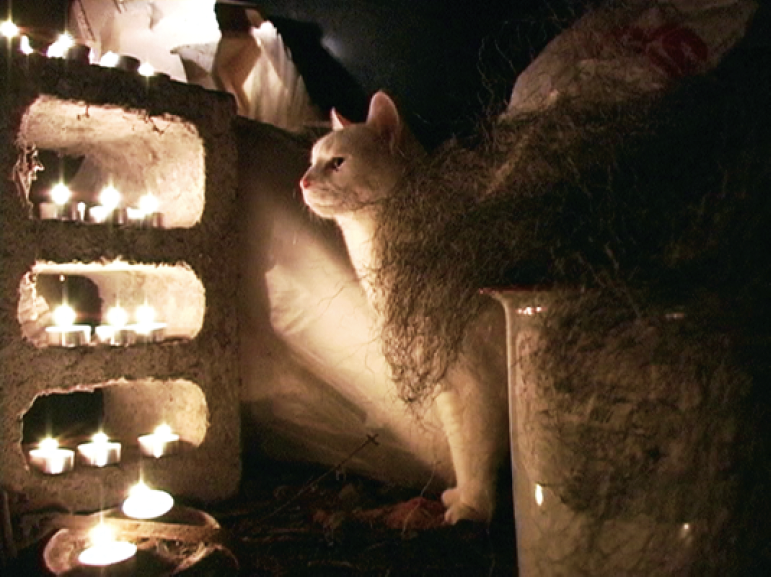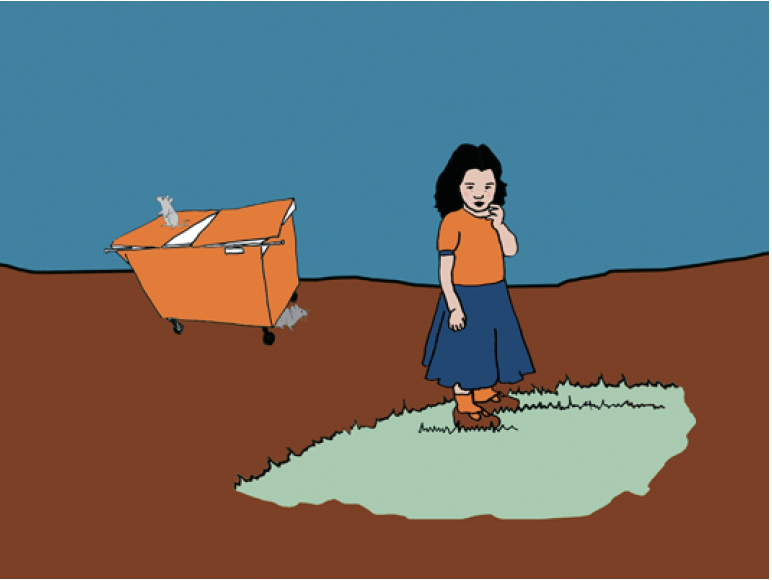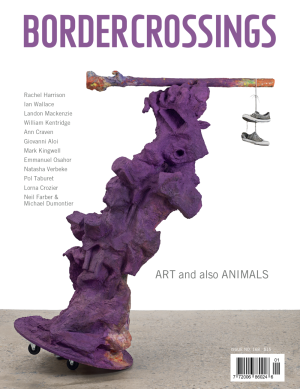“Fantasia”
Human fascination with the grotesque was exercised in full in “Fantasia,” a show featuring works by Shary Boyle, Daniel Barrow and the artist team of Emily Vey Duke and Cooper Battersby. Each reveals the beautiful within the ugly and the speck of hope that lies buried in the pit of despair. Given the current state of world affairs, their messages are timely.

Shary Boyle, Water and Grass, 2005, polymer clay, watercolour and gouache. Photographs courtesy Jessica Bradley Art & Projects, Toronto.
Toronto-based Shary Boyle excels in creating art that is gorgeously twisted. Five tiny Polymer clay figurines, exquisitely modelled in delicate pastel shades, could be ornaments from a young girl’s bedroom but for the strange growths that erupt from their bodies. Golden Cloak spews braided intestines from her shoulders. Taproots has skin of bark, leaves and flowers. A baby sprouts from the mouth of a reclining girl in Integration. We might think them mutants, but the gleeful smiles of these charming, prepubescent creatures speak of an innocent exaltation in their own bodies.

Daniel Barrow, Garbage Man, 2006, from Every Time I See Your Picture I Cry, ink, coloured pencil and collage, 15 7/8 x 17 7/8” framed.
Boyle’s etchings, while peopled with a similar cast of distorted adolescents, succeed in capturing the scarier side of youthful sexuality, their large scale and intense colours lacking the shield of preciousness that gives the sculptures their gentler demeanour. The Peter Pan-like half-figure who drinks so sweetly from a vaginal fountain in the sculpture Water and Grass appears more rapacious as a full-bodied boy who comes upon this erotic geyser.

Emily Vey Duke and Cooper Battersby, “Magic Baby Sequence” and “Dumpster Girl Sequence”, 2006, from video Songs of Praise for the Heart Beyond Cure, 16 minutes.
The suite of seven drawings by Winnipeg’s Daniel Barrow are actually collages of components created for Every Time I See Your Picture I Cry, one of the artist’s “manual animations,” in which individual elements are manipulated on an overhead projector to present a narrative. It is the story of the Garbage Man, a philosophical loner who makes homely craft objects from refuse. The tale also involves a beautiful mother, a serial killer, an infected eye (eyes are a Barrow fetish object) and the quiet satisfaction that can accompany humble domestic tasks such as cleaning the toilet. Getting up close to Barrow’s drawings allows an appreciation of what a fine draughtsman and colourist he is. Combining the manic energy and dour wit of underground comics with a drawing style inspired by vintage children’s book illustrations, Barrow surpasses his sources in the intricacy of his palette and the depth and poignancy of his storylines. The drawings are accompanied by a black and white video that shows how the work appears in a Barrow performance. While this does provide a context for the collage format, the video literally pales in comparison to the real work, and seemed a bit redundant here.

Emily Vey Duke and Cooper Battersby, “Magic Baby Sequence” and “Dumpster Girl Sequence”, 2006, from video Songs of Praise for the Heart Beyond Cure, 16 minutes.
Canadians now living in Syracuse, New York, Vey Duke and Battersby are represented by their video Songs of Praise for the Heart Beyond Cure, a sombre yet highly engaging meditation on the perpetual battles between nature and humankind, life and death, good and evil. The opening segment sets the tone—a bush, bare of leaves but heavy with red autumn berries, is digitally tweaked so that it gently pulsates to worldweary sighs. It is death’s time in the yearly cycle, but berries offer the promise of continued life. The branches become the basis of a swirling kaleidoscope of muted psychedelic patterns. This accompanies the title song, in which Battersby’s sonorous voice promises to “sing to the fallen and to the filth in which they lay.” For the next 15 minutes, very odd filmed and animated vignettes berate humanity for the trail of destruction we leave behind, then cheer us up by illustrating that the will to live may just be strong enough to triumph over our collective idiocy. “The birds come back, which is amazing,” sings Vey Duke, while images of feathered and four-legged forest dwellers scamper past. The drive to seek a way out of the most dismal circumstances is a leitmotiv throughout. A segment filmed in a cluttered basement presents the dank environment of a “very small magic baby” who has germinated in an enamel pot. This intelligent but helpless being alleviates her loneliness by communicating telepathically with a test-tube baby, similarly isolated in a lab. The longest sequence features a monologue by Petra, an adolescent girl who is masterminding the formation of a gang of misfits in order to exact revenge on the popular kids who torment them. The minimalist animation serves to intensify this candid childhood rant, voiced with eerie realism by Battersby. In the final sequence, a shrew that has become an eagle’s dinner, a crackhead and an abused girl sing of their plans to escape their cruel fate. The video closes with the blossoming of a seed that “almost died” before bursting through the soil that would have become its grave, had the force of life not prevailed. The artists in “Fantasia” each remind us that while life may be ugly at times, it’s all we’ve got, so we’d better find those roses in the pile of dung. ■
“Fantasia: Daniel Barrow, Shary Boyle, Cooper Battersby & Emily Vey Duke” was exhibited at Jessica Bradley Art + Projects in Toronto from April 1 to 29, 2006.
Barbara Isherwood is a Toronto-based writer about visual arts.

